<< Previous | Displaying results 6251-6275 of 6769 for "" | Next >>
Jewish wedding in Morocco, 1942. Photo: US Holocaust Memorial Museum, courtesy of YIVO Institute for Jewish Research
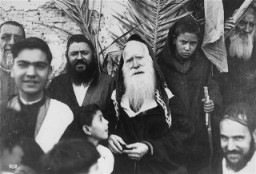
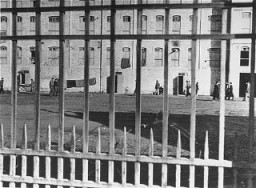
Adolf Berman speaks at a memorial service commemorating the Warsaw ghetto uprising. The building in the background, destroyed during the 1943 uprising, held the office of the Jewish council. Warsaw, Poland, 1945. During the German occupation, Berman was active in the Jewish underground and played a leadership role in the Council for Aid to Jews, known as Zegota.
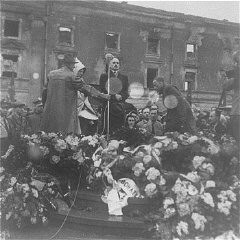
First grade pupils, both Jewish and non-Jewish, study in a classroom in a public school in Hamburg. Germany, June 1933.
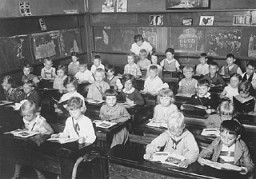
Prewar family photograph of Berta and Inge Engelhard holding pigeons in a public square in Munich. Photograph taken in Munich, Germany, 1937. Following increased anti-Jewish measures, Berta and brother Theo (not pictured here) left Germany on a Kindertransport in January 1939. Inge followed on a different transport a few months later. While the siblings were eventually housed together in England, they faced many challenges during the war including the pain of separation from their parents. Parents Moshe…
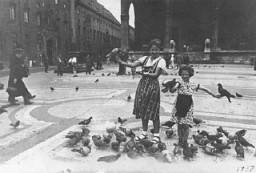
Horst Wessel leads his SA formation through the streets of Nuremberg during the fourth Nazi Party Congress in August 1929.
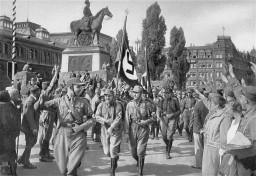
A crowd stands outside of a polling center in Berlin during the German national election in January 1919. This was the first election held under the Weimar Republic (1918–1933), as well as the first election in which women had the legal right to vote in Germany. Women's suffrage was declared in Germany only a couple of months earlier, on November 12, 1918. © IWM Q 110868
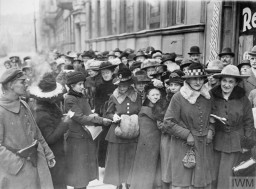
This photo shows a placard urging Hungarian Jews to unite against rising antisemitism in prewar Hungary and Europe. It rallies Jews to protest, using such phrases as: "Protect Jewish honor!”; “Do not buy from our enemies!”; and “Do not watch movies from the Third Reich." Hungary, 1937.
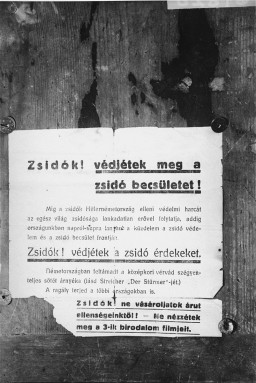
The armistice that ended the hostilities of World War I was signed in a railcar in the Forest of Compiègne. The railcar belonged to French Marshal Ferdinand Foch, the commander of the victorious Allied forces. © IWM Q 61172
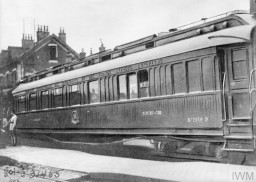
A digital representation of the United States 101st Airborne Division's flag. The US 101st Airborne Division (the "Screaming Eagles" division) was established in 1942. During World War II, they were involved in D-Day and the Battle of the Bulge. The division also captured the city of Eindhoven and uncovered the Kaufering IV camp. The 101st Airborne Division was recognized as a liberating unit in 1988 by the United States Army Center of Military History and the United States Holocaust Memorial Museum…
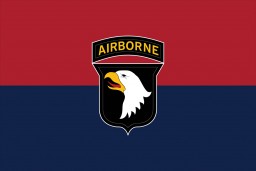
A digital representation of the United States 103rd Infantry Division flag. The US 103rd Infantry Division (the "Cactus" division) was established in 1942. During World War II, they were involved in the Battle of the Bulge and captured the city of Innsbruck. The division also uncovered a Nazi subcamp attached to Kaufering camp complex. The 103rd Infantry Division was recognized as a liberating unit in 1985 by the US Army's Center of Military History and the United States Holocaust Memorial Museum…
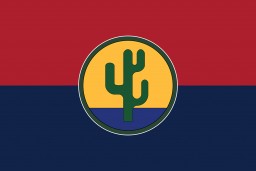
A digital representation of the United States 104th Infantry Division's flag. The US 104th Infantry Division (the "Timberwolf" division) was activated in 1942. During World War II, they captured the cities of Cologne and Halle. The division also overran Nordhausen and the Dora-Mittelbau concentration camp. The 104th Infantry Division was recognized as a liberating unit in 1988 by the United States Army Center of Military History and the United States Holocaust Memorial Museum (USHMM).
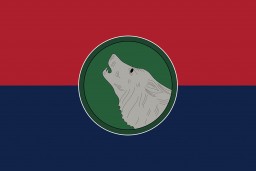
A digital representation of the United States 10th Armored Division's flag. The US 10th Armored Division is also known as the "Tiger" division. During World War II, they captured the cities of Trier and Oberammergau. The division also overran a Dachau subcamp. The 10th Armored Division was recognized as a liberating unit in 1985 by the United States Army Center of Military History and the United States Holocaust Memorial Museum (USHMM).
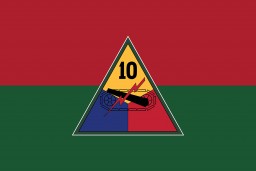
A digital representation of the United States 11th Armored Division's flag. The US 11th Armored Division (the "Thunderbolt" division) was formed in 1942. During World War II, they were involved in the Battle of the Bulge and captured the cities of Coburg, Bayreuth, and Linz. The division also overran the Mauthausen and Gusen concentration camps. The 11th Armored Division was recognized as a liberating unit in 1985 by the United States Army Center of Military History and the United States Holocaust…
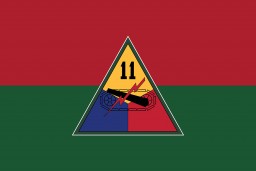
A digital representation of the United States 12th Armored Division's flag. The US 12th Armored Divison is also known as the "Hellcats" division. During World War II, they captured the cities of Ludwigshafen and Würzburg. The division also overran a subcamp of Dachau. The 12th Armored Division was recognized as a liberating unit in 1988 by the United States Army Center of Military History and the United States Holocaust Memorial Museum (USHMM).
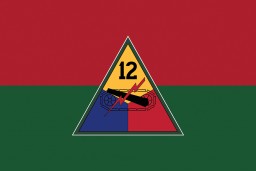
A digital representation of the United States 14th Armored Division's flag. The US 14th Armored Division (the "Liberators" division) joined the war in 1944. During World War II, they uncovered several subcamps of Dachau, three large forced-labor camps, and several other nearby camps. The 14th Armored Division was recognized as a liberating unit in 1991 by the United States Army Center of Military History and the United States Holocaust Memorial Museum (USHMM).

A digital representation of the United States 1st Infantry Division's flag. The US 1st Infantry Division (the "Big Red One" division) was formed in 1917 and fought in World War I. During World War II, they were involved in the Allied invasions of North Africa and Italy, as well as D-Day and the Battle of the Bulge. Additionally, the division captured the city of Aachen and liberated Zwodau and Falkenau an der Eger, two subcamps of Flossenbürg. The 1st Infantry Division was recognized as a liberating…
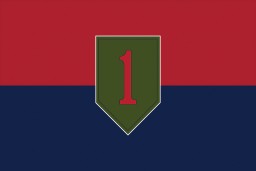
A digital representation of the United States 20th Armored Division's flag. The US 20th Armored Division was occasionally known as the "Armoraiders" during World War II. They participared in the liberation of the Dachau concentration camp. The 20th Armored Division was recognized as a liberating unit in 1985 by the United States Army Center of Military History and the United States Holocaust Memorial Museum (USHMM).
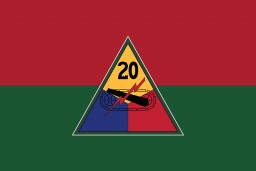
A digital representation of the United States 26th Infantry Division's flag. The US 26th Infantry Division (the "Yankee" division) was formed in 1917 and fought in World War I. During World War II, they were involved in the Battle of the Bulge and captured the city of Linz. The division also overran the Gusen concentration camp. The 26th Infantry Division was recognized as a liberating unit in 2002 by the United States Army Center of Military History and the United States Holocaust Memorial Museum…
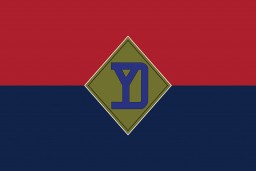
A digital representation of the United States 29th Infantry Division's flag. The US 29th Infantry Division (the "Blue and Gray" division) was established in 1917 and fought in World War I. During World War II, they were involved in D-Day, as well as the liberation of Dinslaken civilian labor camp. The 29th Infantry Division was recognized as a liberating unit in 1995 by the United States Army Center of Military History and the United States Holocaust Memorial Museum (USHMM).

A digital representation of the United States 2nd Infantry Division's flag. The US 2nd Infantry Division (the "Indianhead" division) was created in 1917 and fought in World War I. During World War II, they were involved in D-Day and the Battle of the Bulge. They also captured the cities of Leipzig and Hadamar. Additionally, the division overran Leipzig-Schönefeld, a subcamp of Buchenwald, and liberated prisoners at the Spergau/Zöschen camp. The 2nd Infantry Division was recognized as a liberating unit…
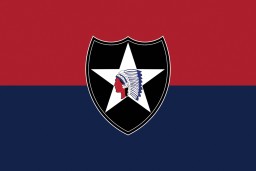
A digital representation of the United States 30th Infantry Division's flag. The US 30th Infantry Division (the "Old Hickory" division) was established in 1917 and fought in World War I. During World War II, they were involved in the Battle of the Bulge and also liberated Weferlingen, a subcamp of Buchenwald. The 30th Infantry Division was recognized as a liberating unit in 2012 by the United States Army Center of Military History and the United States Holocaust Memorial Museum (USHMM).
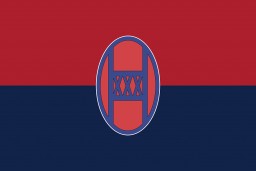
A digital representation of the United States 36th Infantry Division's flag. The US 36th Infantry Division (the "Texas" or "Lone Star" division) was established in 1917 and fought in World War I. During World War II, they were involved in the Allied invasions of North Africa and the Battle of the Bulge. The division also overran some of the Kaufering subcamps of the Dachau concentration camp. The 36th Infantry Division was recognized as a liberating unit in 1995 by the United States Army Center of…
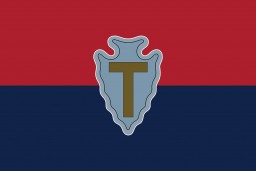
A digital representation of the United States 3rd Armored Division's flag. The US 3rd Armored Division (the "Spearhead" division) was established in 1941. During World War II, they were involved in the Battle of the Bulge and captured the city of Cologne. The division also discovered the Dora-Mittelbau concentration camp. The 3rd Armored Division was recognized as a liberating unit in 1985 by the United States Army Center of Military History and the United States Holocaust Memorial Museum (USHMM).
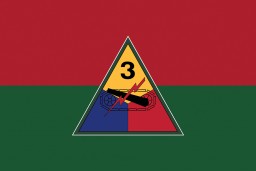
A digital representation of the United States 42nd Infantry Division's flag. The US 42nd Infantry Division (the "Rainbow" division) was established in 1917 and fought in World War I. During World War II, they captured the cities of Würzburg, Schweinfurt, and Fürth. The division also entered the Dachau concentration camp. The 42nd Infantry Division was recognized as a liberating unit in 1985 by the United States Army Center of Military History and the United States Holocaust Memorial Museum…

We would like to thank Crown Family Philanthropies, Abe and Ida Cooper Foundation, the Claims Conference, EVZ, and BMF for supporting the ongoing work to create content and resources for the Holocaust Encyclopedia. View the list of donor acknowledgement.